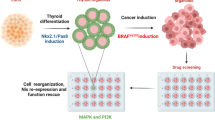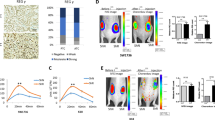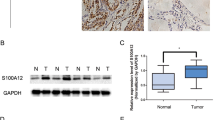Abstract
Anaplastic thyroid cancer (ATC) is an aggressive, fatal disease unresponsive to traditional therapies, generating a need to develop effective therapies. The PAX8/PPARγ fusion protein (PPFP) has been shown to favorably modulate tumor growth in follicular thyroid cancer, prompting our evaluation of its efficacy to inhibit ATC cell and tumor growth in vitro and in vivo. PPFP was constitutively expressed in five ATC cell lines: BHT-101, FRO, C-643, KTC-2 and KTC-3, and inhibited cell growth in four of five cell lines and xenograft tumor growth in four of four cell lines. PPFP-mediated growth inhibition involved multiple mechanisms, including upregulation of miR-122 and miR-375, associated with decreased angiogenesis and AKT pathway inactivation, respectively. Also, PPFP expression resulted in marked increase of thyroid-specific marker transcripts, including PAX8, thyroid peroxidase (TPO), sodium iodide symporter (NIS) and thyroglobulin, to varying degrees by activating their respective promoters, suggesting that PPFP induced cellular redifferentiation. Functional studies demonstrate that increased NIS messenger RNA is not associated with increased 125I uptake. However, ectopic expression of wild-type NIS-induced perchlorate-sensitive iodine uptake, suggesting that endogenous NIS in ATC cell lines is defective. As current treatment for ATC is only palliative, overexpression of PPFP may offer a novel therapeutic strategy for the treatment of ATC.
This is a preview of subscription content, access via your institution
Access options
Subscribe to this journal
Receive 12 print issues and online access
$259.00 per year
only $21.58 per issue
Buy this article
- Purchase on Springer Link
- Instant access to full article PDF
Prices may be subject to local taxes which are calculated during checkout





Similar content being viewed by others
References
Siegel R, DeSantis C, Virgo K, Stein K, Mariotto A, Smith T et al. Cancer treatment and survivorship statistics, 2012. CA Cancer J Clin 2012; 62: 220–241.
McIver B, Hay ID, Giuffrida DF, Dvorak CE, Grant CS, Thompson GB et al. Anaplastic thyroid carcinoma: a 50-year experience at a single institution. Surgery 2001; 130: 1028–1034.
Smallridge RC, Copland JA . Anaplastic thyroid carcinoma: pathogenesis and emerging therapies. Clin Oncol (R Coll Radiol) 2010; 22: 486–497.
Smallridge RC, Marlow LA, Copland JA . Anaplastic thyroid cancer: molecular pathogenesis and emerging therapies. Endocr Relat Cancer 2009; 16: 17–44.
Eberhardt NL, Grebe SK, McIver B, Reddi HV . The role of the PAX8/PPARgamma fusion oncogene in the pathogenesis of follicular thyroid cancer. Mol Cell Endocrinol 2010; 321: 50–56.
Sahin M, Allard BL, Yates M, Powell JG, Wang XL, Hay ID et al. PPARgamma staining as a surrogate for PAX8/PPARgamma fusion oncogene expression in follicular neoplasms: clinicopathological correlation and histopathological diagnostic value. J Clin Endocrinol Metab 2005; 90: 463–468.
Reddi HV, Madde P, Milosevic D, Hackbarth JS, Algeciras-Schimnich A, McIver B et al. The putative PAX8/PPARgamma fusion oncoprotein exhibits partial tumor suppressor activity through up-regulation of micro-RNA-122 and dominant-negative PPARgamma activity. Genes Cancer 2011; 2: 46–55.
Schweppe RE, Klopper JP, Korch C, Pugazhenthi U, Benezra M, Knauf JA et al. Deoxyribonucleic acid profiling analysis of 40 human thyroid cancer cell lines reveals cross-contamination resulting in cell line redundancy and misidentification. J Clin Endocrinol Metabol 2008; 93: 4331–4341.
Reddi HV, Madde P, Marlow LA, Copland JA, McIver B, Grebe SK et al. Expression of the PAX8/PPARgamma fusion protein is associated with decreased neovascularization in vivo: impact on tumorigenesis and disease prognosis. Genes Cancer 2010; 1: 480–492.
Denizot F, Lang R . Rapid colorimetric assay for cell growth and survival. Modifications to the tetrazolium dye procedure giving improved sensitivity and reliability. J Immunol Meth 1986; 89: 271–277.
Castro MR, Bergert ER, Beito TG, McIver B, Goellner JR, Morris JC . Development of monoclonal antibodies against the human sodium iodide symporter: immunohistochemical characterization of this protein in thyroid cells. J Clin Endocrinol Metabol 1999; 84: 2957–2962.
Spitzweg C, Dietz AB, O'Connor MK, Bergert ER, Tindall DJ, Young CY et al. In vivo sodium iodide symporter gene therapy of prostate cancer. Gene Ther 2001; 8: 1524–1531.
Monahan P, Rybak S, Raetzman LT . The Notch target gene Hes1 regulates cell cycle inhibitor expression in the developing pituitary. Endocrinology 2009; 150: 4386–4394.
Goel A, Carlson SK, Classic KL, Greiner S, Naik S, Power AT et al. Radioiodide imaging and radiovirotherapy of multiple myeloma using VSV(Delta51)-NIS, an attenuated vesicular stomatitis virus encoding the sodium iodide symporter gene. Blood 2007; 110: 2342–2350.
Xu Y, Deng Y, Yan X, Zhou T . Targeting miR-375 in gastric cancer. Expert Opin Ther Targets 2011; 15: 961–972.
Li X, Lin R, Li J . Epigenetic silencing of microRNA-375 regulates PDK1 expression in esophageal cancer. Dig Dis Sci 2011; 56: 2849–2856.
Tsukamoto Y, Nakada C, Noguchi T, Tanigawa M, Nguyen LT, Uchida T et al. MicroRNA-375 is downregulated in gastric carcinomas and regulates cell survival by targeting PDK1 and 14-3-3zeta. Cancer Res 2010; 70: 2339–2349.
El Ouaamari A, Baroukh N, Martens GA, Lebrun P, Pipeleers D, van Obberghen E . miR-375 targets 3′-phosphoinositide-dependent protein kinase-1 and regulates glucose-induced biological responses in pancreatic beta-cells. Diabetes 2008; 57: 2708–2717.
Gerard CM, Lefort A, Christophe D, Libert F, Van Sande J, Dumont JE et al. Control of thyroperoxidase and thyroglobulin transcription by cAMP: evidence for distinct regulatory mechanisms. Mol Endocrinol 1989; 3: 2110–2118.
Acknowledgements
This work was supported by a research grant from the Fraternal Order of Eagles (HVR) and Mayo Foundation (NLE). We thank Dr Stephen Russell for the VSV-NIS virus and Dr Mark J. Federspiel and the staff of the Viral Vector Production Laboratory for supplying clinical grade VSV-NIS.
Author information
Authors and Affiliations
Corresponding authors
Ethics declarations
Competing interests
The authors declare no conflict of interest.
Rights and permissions
About this article
Cite this article
Reddi, H., Driscoll, C., Madde, P. et al. Redifferentiation and induction of tumor suppressors miR-122 and miR-375 by the PAX8/PPARγ fusion protein inhibits anaplastic thyroid cancer: a novel therapeutic strategy. Cancer Gene Ther 20, 267–275 (2013). https://doi.org/10.1038/cgt.2013.16
Received:
Revised:
Accepted:
Published:
Issue Date:
DOI: https://doi.org/10.1038/cgt.2013.16
Keywords
This article is cited by
-
MiR-375 and YAP1 expression profiling in medullary thyroid carcinoma and their correlation with clinical–pathological features and outcome
Virchows Archiv (2017)
-
Tumor suppressor control of the cancer stem cell niche
Oncogene (2016)
-
Establishment, Characterization and Comparison of Seven Authentic Anaplastic Thyroid Cancer Cell Lines Retaining Clinical Features of the Original Tumors
World Journal of Surgery (2014)
-
Association between a functional insertion/deletion polymorphism in IL1A gene and risk of papillary thyroid carcinoma
Tumor Biology (2014)



